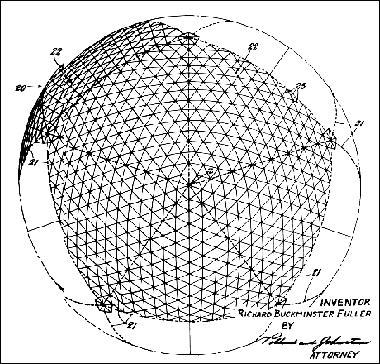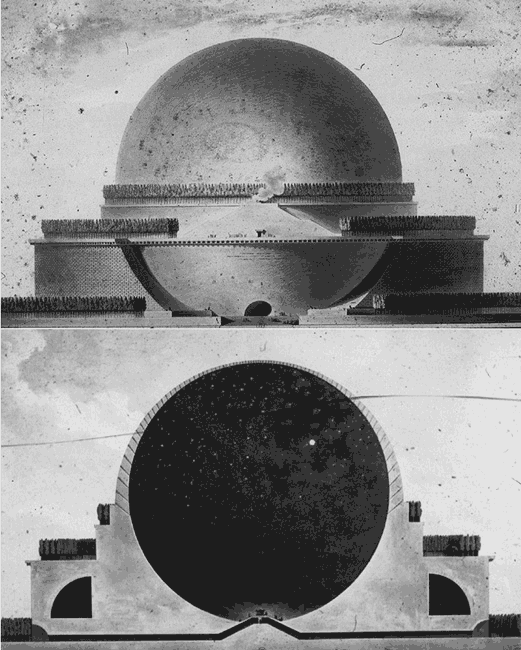In geometry, a geodesic is a curve whose principal normal at any given point is the normal to the surface on which the curve occurs: or, the shortest line between two points on any mathematically derived surface (from Greek geodaisia, "division of the earth": geo + daiesthai, to divide). Like Mercator's longitudes and latitudes, or the lines on contour maps, geodesics function as agents of territoriality, a geometry of transference and translation, situated on a meridian between complex topological space and the two-dimensional grid, between geodetic survey and cartographic projection. (See Buckminster Fuller's Dymaxion Map of the world, which uniquely achieves a two dimensional projection of the almost continuous continental landmasses, without distortion of scale)
The geodesic is a form of curvature which "tends" towards both the linear and polyvalent, a vector between two points describing a distance which increasingly approaches zero. At the same time it represents a mode of interconnectivity, network, rhizome: a tendency towards "simultaneity" in space equivalent to the reduction in time towards light speed data processing. As Virilio says, "space, or critical extension, has become ubiquitous, because of the acceleration of 'means of communication' [...]. Today we are beginning to realise that systems of telecommunication do not merely confine extension, but that, in the transmission of messages and images, they also eradicate duration or delay." For this reason, too, the polyhedral organisation of geodesic networks describes a system of dissipation.

Taking as an example Buckminster Fuller's Geodesic Dome (U.S. Pavilion, Expo 67, Montréal), it is possible to see how dissipative effects in informatic systems can be compared to the structurally "communicating" vectors of geodesics (or the geodesic spheroid). In Fullers model, structural tension is seen to be spread out over the entire area of the dome's surface. Local effects are globalised. The point-to-point polyhedral structure not only describes interconnections, but also a field of hyper-mediation (each point communicates with every other point). There is no unique direction of transference or translation of effects, no hypotactic régime of semantic subordination between structural elements. In this sense, the geodesic curvature also describes a type of clinamen, a strophic "turning away," or "swerve." In place of lineality, translation, co-extensivity, the effect of the clinamen suggests an architectonic détournement, recursion and ellipsis, or what chaos theorists describe as a virtual.
Consequently, the clinamen may be thought as describing the relation of the geodesic to the geo-graphic, or to the geo-political, as one of programmatic recursion (map-territory), at the same time as it provides the condition upon which these relations are affected. The radical asymmetry of this relationship implies a structural geometry which accords not with a centrific globalisation but rather with a textual remediation of "possible worlds": between Leibnizian monadology and the "endless scenario model" of a n-dimensional hypersphere. This topological, cybernetic apparatus likewise describes what Fuller elsewhere terms "synergetics," or the "geometry of thought." But while this points in one direction to the use of virtual media as models for cognitive science and artificial intelligence (the "nature of mind"), it also points back in the direction of the historical rationalising of geo- and bio-space: the Cartesian project of attributing something like a mental organisation to the world at large.

As with all cybernetic models, Fuller's geodesy communicates, in an essential way, with certain principles of the Enlightenment and the legacy of Descartes and Newton's rationalised, mechanistic universe. But it is by means of an otherwise unlikely detour that the geodetic project of Fuller can be seen as achieving a somewhat clairvoyant and curiously apt expression in Etienne-Louis Boullée's unrealised "Project for a cenotaph for Sir Isaac Newton" (1784). Boullée's cenotaph was in fact an enormous planetarium contained within a massive "globular void" described by the monument's spherical interior (whose upper half simulated a map of the firmament). The drawings for the project are minimalistically severe, grey and black, resembling a cross-sectional diagram of an engine casing. The cenotaph more effectively recalls the sinister genius of Blake's Urizon, and despite its monumentality the project gives the impression of an oppressive constriction of space similar to that typical of 20th-century utopianist architecture.
The "geometry of thought" expressed in Boullée's project is one of closed totality: the cincture of a reason which is at once all seeing and sightless. It seems hardly a coincidence that the Newton cenotaph equally resembles an unseeing eye, a negative dilation of space, en abyme, like Hamlet's universe enclosed in a nutshell or Borges's "Aleph." The structure itself is organised by an internalised visuality and the simulation of optical space (a black spheroid with holes punctuating the upper half imitating a static arrangement of celestial bodies). It seems to echo that most conspicuous manifestation of the rational consciousness, Jeremy Bentham's panopticon, in which the emptiness of Newton's cenotaph finds its analogy in the virtuality of the surveillance mechanism: the ultimate expression, perhaps, of the Cartesian artifex maximus.
While the history of the panopticon has been ably traced by Foucault and others, there are yet several moments belonging to it which need to be more fully explored. One of these is described by that otherwise fortuitous encounter between the Enlightenment and Romanticism in the mechanisation of landscape. The reinvention of the pastoral has long been seen for what it was, a sublimation of industrial urbanisation, on the one hand, and a rationalisation (and "technologisation") of nature on the other. Between Henry Flitcroft's Stourhead park (1765), for example, and Robert Owen's (and Jeremy Bentham's) New Lanark mills (1811), there are perhaps only dissimilarities in the exterior organisation and orientation of their respective technics. New Lanark was an early model bio-sphere: a geodesic between environmentalism and economic output: the median of applied "interface ecology." 18th-century landscaping, with its rational Palladian architecture like a surveying ego projected into the landscape, centring an entirely simulated "nature" (replete with manufactured ruins, artificial lakes, hills, valleys and rusticated "populace"), similarly described a relation between structuralised "landscape" and the aesthetics of utopian visual repose.
While in both of these cases nature is equated with a concept of labour, the focus on production is nevertheless structured by an aesthetics of the spectacle. Labour is seen to be at work in the service of its own edification, its own benefaction, as an end in itself. The social engineer, like the landscape artist and his patron, gains aesthetic and moral gratification from the spectacle of nature's good work, achieved under his intervening pastoral guidance and supervision (a geo-desics mirrored in the division and organisation of labour). The convergence of Enlightenment paternalism and Romantic ecological primitivism here has a number of interesting formal corollaries. These have to do not only with the juxtaposition of "styles," radical containment and functional autonomy, or the synthetic basis of its nature-truth idealism, but with the "radicalisation" of the pastoral genre.
In the mode of appropriation common to primitivism and paternalism, the "synthetics" of ideality arises in a two-fold movement of deracination (transposition). The pastoral mode in this sense is implicitly counter-radical at the same time as establishing a "radicalism" rooted in the absence of any ground to which it might directly refer (without making a detour through "other" configurations). In Synergetics Fuller argues that "It is a tendency for patterns either to repeat themselves locally or for their parts to separate out to join singly or severally with other patterns to form new constellations. All the forces operative in the Universe result in a complex progression of [...] rearrangings in which the macro-medio-micro [...] events stand dynamically together here and there as locally regenerative patterns." (601.01)
Boullée's cenotaph, Owen's Lanark, Bentham's panopticon, Fuller's geodesic dome, might then each be seen as a matrix of spatio-temporal transposition, auto-poiesis, or what Andruid Kerne refers to as a "collage machine," as agents of "interface ecology." Like Braque and Picasso's cubistic grid, the surface effect of the pastoral "genre" is also a mechanism of analysis and synthesis, recombination, collage or montage, whose material organisation is subject to aesthetic revaluation (as nature morte) and whose semantic content can no longer be reduced to the socio-political intention or causation assumed to be integral to it. The "collage" effect is one of a certain indifference: beyond the infra-structural grid there are only variables, whose semantic complexion is determined above all by the context which the mechanics of transposition assigns to it, and not by any claim to a prior (more authentic) context.





